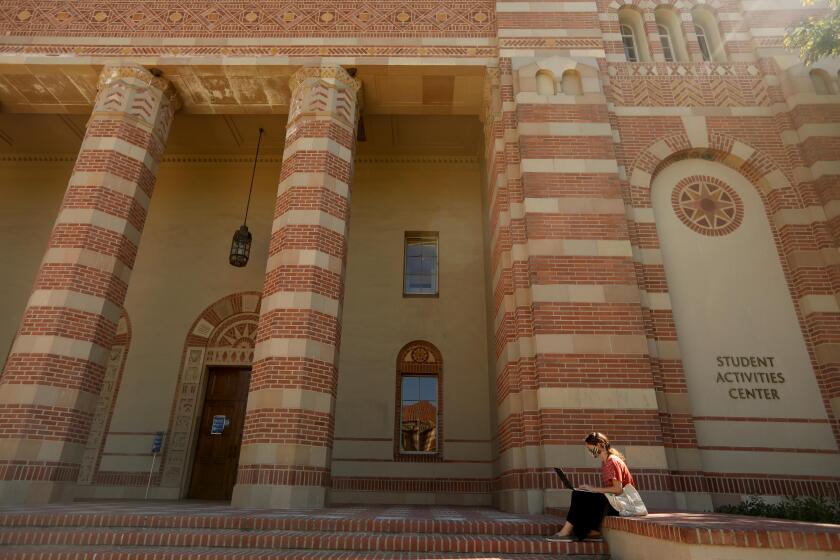A LOOK AHEAD: Students from two Los Angeles schools are cleaning streams and planting trees in local wilderness areas. The Eco-Heroes campaign is expected to spread as young people continue . . . : Reaping Benefits While Sowing Environmental Hope
- Share via
Armed with shovels, gloves and a sense of awe, the first of what could become an army of teenage environmentalists is fanning out in local mountains to plant trees, clean streams and try to change attitudes.
They are the Eco-Heroes--high school students recruited by forestry officials, a statewide ecology group and a new UCLA social research center to help in overrun and underfunded wilderness areas.
Youths from El Camino Real High in Woodland Hills and Garfield High in East Los Angeles have helped launch the campaign with monthly work trips into the forest.
Pleased with the results, officials are mapping plans to extend the project to every high school in Los Angeles.
Teenagers say their tree-planting and cleanup work is opening their eyes to the potential--and the problems--faced by urban wilderness lands.
“I’d never been to the mountains before. It was surprising that this is so close to home,” Garfield High senior Cecilia Islas, 17, said Friday as she helped plant a tiny Douglas fir at Crystal Lake in the mountains north of Glendora.
“But it was also surprising how people take advantage of this place, leaving trash and things like dirty diapers scattered around. Writing graffiti on things.”
Classmate Veronica Villanueva nodded in agreement. “I’ll be giving pointers to people about the mountains when I get home. I’m going to tell them not to throw their garbage in the river when they come up here. I’m going to tell them to take care of this place,” she said.
There was a similar attitude among El Camino Real students who traveled a few days earlier to Big Tujunga Canyon in the mountains above Sunland.
“The first time we came up here we cleaned up garbage and old diapers that people have left behind,” said Piper Harris, a 17-year-old senior from Tarzana. “It was disgusting. It was unbelievable.”
That wasn’t the only surprise. El Camino students were dismayed to see a 600-year-old oak tree lying on the ground at Vogel Flats, where they were planting oak seedlings.
Forester Julie Molzahn told them that insects had attacked the tree through holes carved and hacked by forest visitors. The tree then rotted and died.
“I’ve carved my name in trees before, but I’ll never do it again,” vowed 11th-grader Elizabeth Givens, 17. “Reading something in a book just tells you about the environment. Coming out and seeing things with your own eyes makes you experience it.”
The Eco-Heroes concept is the brainchild of David Bloome, a 34-year-old administrator at UCLA’s Advanced Policy Institute. It is a 2-year-old division of the UCLA School of Public Policy and Social Research.
*
Bloome said he got the idea of involving high school students after participating in a volunteer cleanup day along Piru Creek in Ventura County.
“The canyon was trashed, but only 12 people showed up to help clean it,” Bloome said. “On the way back home I drove past a high school and saw all the kids and all of their untapped energy. I started thinking of ways to involve them.”
According to Bloome, plans to draw Los Angeles high school students into mountain restoration work fell quickly into place when the U.S. Forest Service, the California Environmental Project and the Los Angeles Unified School District agreed to link up with his UCLA group.
The four organizations settled on a concept that calls for all 53 city high schools to be part of the program by September 2001. The plan is to recruit 200 motivated students from each school, divide them into groups of 50 and send each group out to wilderness areas three times each school year.
The tree-planting and cleanup trips will cost about $1.2 million a year once the program is in full swing. Organizers have begun seeking corporate financial support.
Bloome has memorized the figures: “We’re talking $118 per kid. That’s 53 schools, 200 kids per school, 10,600 kids altogether. That’s 159,000 hours of volunteer service a year.”
Eight more schools will join Eco-Heroes next year, he said. As more schools are added, cleanup and restoration projects will be launched along the Los Angeles River, in the Santa Monica Mountains, along Los Angeles County beaches and in local wetlands, according to Bloome.
A spokeswoman for the school district’s high school division said Friday that administrators there are pleased with the Eco-Heroes plan.
Jeff Gantman, program director for the Glendale-based nonprofit California Environmental Project, said the project will help teach future generations about their role and responsibility in the natural environment.
“It’s going to fly,” he predicted.
*
Teachers from Garfield and El Camino, who accompany the students on the monthly trips that began last fall, agree.
Students in East Los Angeles now stop chemistry and environmental sciences instructor Michelle Barker in the hallway to beg for membership in Eco-Heroes, she said.
Peter Vastenhold, an anatomy and physiology teacher in Woodland Hills, said students are dazzled by the mountains. “A lot of these kids are mall kids,” he said. “To realize the forest is their own L.A. backyard is a revelation of sorts.”
East Los Angeles student Cecilio Vallejo, 16, said he plans to return with his own children some day to show them the pine trees he planted Friday. “I’ll tell my kids, ‘I did this, and I hope you do something like this too,’ ” he said.
Woodland Hills student Erin Yale, 17, had a name for the oak tree she planted and carefully watered. It’s a name that Eco-Heroes leaders say may be prophetic for Los Angeles’ wilderness.
“We named her ‘Hope,’ ” Yale said proudly. “She’s going to do real well.”
More to Read
Sign up for Essential California
The most important California stories and recommendations in your inbox every morning.
You may occasionally receive promotional content from the Los Angeles Times.











